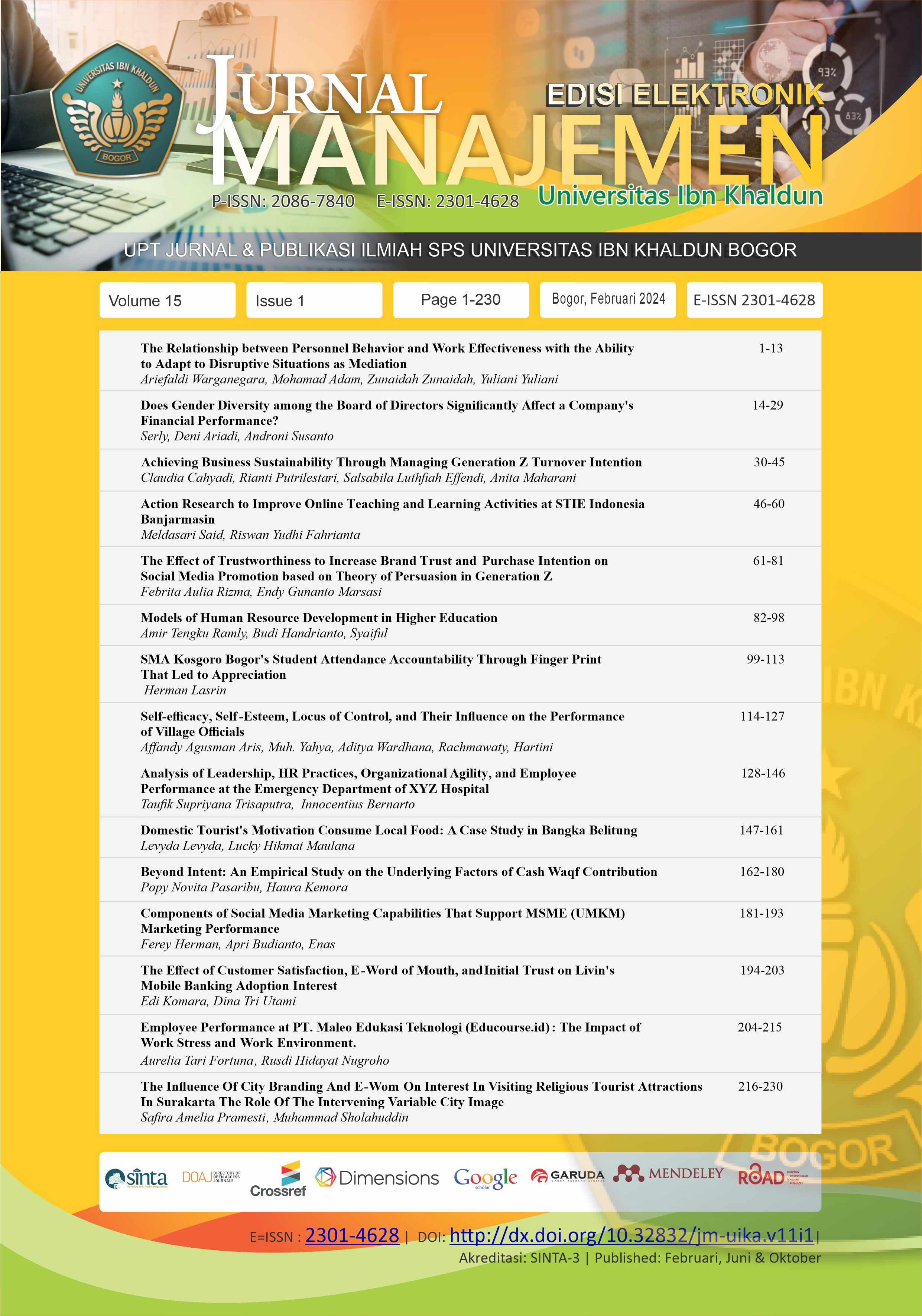Competency-Based Model of Human Resource Development in Higher Education
DOI:
https://doi.org/10.32832/jm-uika.v15i1.15446Keywords:
HRM, Tree HR Model, CompetencyAbstract
This research aims to find the model that best suits the development of Human Resources (HR) in higher education based on the competencies determined by the Indonesian National Work Competency Standards (SKKN). Until now, HR competency standards in higher education have not been standardized, making it difficult to prepare HR development models. Meanwhile, various HR development models are being implemented by the industrial sector. Meanwhile, human resource development in higher education still focuses only on lecturers. There are educational staff (tendik) who are human resources that also need to be developed. The research was conducted using qualitative methods through literature reviews and interviews with HR experts in organizations, companies and the academic world. The results were analyzed using SWOT (Swot Analysis) and decided by experts in a Focus Group Discussion (FGD). The results of this research found important variables that were mapped to the tree structure, namely root variables, stem variables, and fruit/leaf variables
References
Afri Mahdane et al. (2018), Pengaruh SKKNI dan Kompetensi SDM terhadap Pengembangan SDM di Unit Profesi SDM dalam Menghadapi Era MEA, Jurnal Manajemen IKM IPB, 13(1), 1-9. https://doi.org/10.29244/mikm.13.1.1-9.
Akiko Ueno (2014), Developing a conceptual model illustrating how HRM practices support each other in order to improve service quality, Jurnal Procedia - Social and Behavioral Sciences, 148 (2014), (24 – 31), https://doi.org/10.1016/j.sbspro.2014.07.011
Al-Attas, Muhammad Naquib (1979). Aims and Objectives of Islamic Education, Jeddah: King Abdul Aziz University.
Beer, M., Spector, B., Lawrence, P. R., Mills, D. Q., and Walton, R. E. (1984). A Conceptual View of HRM. Managing Human Assets. Free Press, New York Chap. 2.
Dimas Agung Trisliatanto, et al., (2016), The Competency Development Model Based On Performance Orientation And Team Work, Jurnal Manajemen dan Kewirausahaan, 18(2), 152–162. https://doi.org/10.9744/jmk.18.2.%25p.
Guest, D. (2002). Human Resource Management, Corporate Performance and Employee Wellbeing: Building the Worker into HRM. The Journal of International Relations, 44(3), 335–358
Hendry, C. and Pettigrew, A. (1990), Human Resource Management: An Agenda for the 1990s, International Journal of Human Resource Management, 1(1), 17–43. https://doi.org/10.1080/09585199000000038.
Inga Lapiņa, et al. (2014), Human resource management models: aspects of knowledge management and corporate social responsibility, Jurnal Procedia - Social and Behavioral Sciences, 110 (2014), 577 – 586. https://doi.org/10.1016/j.sbspro.2013.12.90
Ino Bechtryanto, et al., (2021), Model Pengembangan Sumber Daya Manusia di Lembaga Pendidikan Islam, Jurnal Reflektika, 16(1). 10.47736/tajdidukasi.v8i1.303
IPB (2012). Indikator Kinerja Kunci Menuju IPB sebagai Learning Organization Unggul. Bogor: SIM Institut Pertanian Bogor.
Junaidah, H. (2009), Islamic Revival in Human Resource Management Practices among Selected Islamic Organizations in Malaysia, International Journal of Islamic and Middle Eastern Finance and Management, 2(3), 251–267. https://doi.org/10.1108/17538390910986362
Lisdartina1, Rini Setyaningsih, (2021), Teori dan Model Pengembangan Sumber Daya Manusia di Lembaga Pendidikan Islam Menurut Ahmad Fatah Yasin, Jurnal Pendidikan Islam Al-Ulya, 6(1), 1 – 10. https://doi.org/10.36840/ulya.v6i1.381
Luis Marnisah, et al., (2022), Employee Performance Based On Competency, Career Development, And Organizational Culture, Journal of Applied Management (JAM), 20(3). http://dx.doi.org/10.21776/ub.jam.2022.020.03.13
M, Armstrong. (2000). Strategic Human Resource Management: A Guide to Action. Kogan Page Publisher, Part 2.
Nur Syuhada Ab Ghani, Maslin Masrom, (2014), Human Resource Management Practice Models Applied in Banking Industry: A Review, Jurnal Sains Humanika, 2(2), 37–42. https://doi.org/10.11113/sh.v2n2.411
Ramly, A.T., Tanjung, H. (2021) Tree Model In Human Resource Management Based On Personality, Competence And Spirituality To Improve Organizational Performance. Academy of Strategic Management Journal, 20(3), pp. 1–13
Ramly, A. T. (2019). Evaluation of Pumping HR (Human Resources) Model-Based Training Program on Human Resources Development at Bogor Agricultural University (IPB). Integrated Journal of Business and Economics, 3(2), 153-163.
Simanora, Henry (1999), Manajemen Sumber Daya Manusia Edisi Kedua. Yogyakarta: Bagian Penerbitan ST Ilmu Ekonomi
Spencer, M. L. & Spencer, M. S. (2010), Models of competency and performance. New York: John Wiley & Sons
Usman, H. (2014). Manajemen. Jakarta: PT Bumi Aksara
Vareta Nyamupa Chari (2010), Importance of Resource Planning Organizations. Brazza Villa: Gongo.
Velde, C. (2010), Application of competence development model, International Journal of World Business, 3(2), 10–18.
Downloads
Published
How to Cite
Issue
Section
License
Copyright (c) 2024 Jurnal Manajemen (Edisi Elektronik)

This work is licensed under a Creative Commons Attribution-NonCommercial 4.0 International License.
Authors who publish with this journal agree to the following terms:
- Authors retain copyright and grant the journal right of first publication with the work simultaneously licensed under a Creative Commons Attribution-NonCommercial-ShareAlike 4.0 International License that allows others to share the work with an acknowledgement of the work's authorship and initial publication in this journal.
- Authors can enter into separate, additional contractual arrangements for the non-exclusive distribution of the journal's published version of the work (e.g., post it to an institutional repository or publish it in a book), with an acknowledgement of its initial publication in this journal.
- Authors are permitted and encouraged to post their work online (e.g., in institutional repositories or on their website) prior to and during the submission process, as it can lead to productive exchanges, as well as earlier and greater citation of published work (See The Effect of Open Access).











